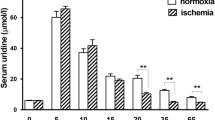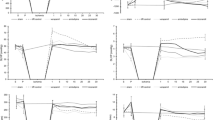Summary
As criterion for the degree of ischemic stress on myocardium during repeated cronary artery occlusion, the reproducibility of the release of potassium, lactate and inorganic phosphate in the early reperfusion period was examined.
On 20 anaesthetized open-chest mongrel-dogs, local ischemia was induced by intermittent occlusion of the LAD artery. In each experiment the artery was occluded for 3 min 4 to 6 times with intervals of 45 min. Just before beginning, at the end of occlusion and after 5 min of reperfusion, arterial and coronary venous blood was collected simultaneously. Additionally, 3 ml of blood were withdrawn by syringe-pumps during the first minute of reperfusion.
Intraindividually, the following standard-deviations were found in a representative experiment with 5 occlusions: potassium ±7% (22.62±1.6 μmol/min); inorganic phosphate ±9% (19.82±2.06 μmol/min); lactate ±11% (55.38±5.93 μmol/min).
Interindividually, the correlation between the release of these markers and the perfusion bed of the ligated artery led to coefficients of about r∼0.88. On an average, per gram ischemic tissue/wet weight 0.74 μmol potassium, 0.6 μmol inorganic phosphate and 1.98 μmol lactate were released. The ratios between the releases remained constant independent of the size of ischemic area. An even closer correlation with coefficients of about r∼0.97 was found between the releases and the O2-debt in the occlusion period.
Based on a synoptic assessment of metabolic and energetic parameters, this experimental model may render more detailed information on pharmacological interventions during ischemic stress.
Similar content being viewed by others
References
Ross J (1976) Electrocardiographic ST-segment analysis in the characterization of myocardial ischemia and infarction. Circulation 53, Suppl 1:73–81
Jennings RB, Ganate CE, Reimer KA (1975) Ischemic tissuc injury. Am J Pathol 81:179–198
Shell WE, Kjekshus JK, Sobel BE (1971) Quantitative assessment of the extent of myocardial infarction in the conscious dog by means of analysis of serial changes in serum creatine phosphokinase (CPK) activity. J Clin Invest 50:2614–2625
Cox JL, McLaughlin, Flowers NC, Horan LG (1968) The ischemic zone surrounding acute myocardial infarction: its morphology as detected by dehydrogenase staining. Am Heart J 76:650
Holman BL (1976) Radionuclide methods in the evaluation of myocardial ischemia and infarction. Circulation 53, Suppl 1:112–119
Case RB, Nasser GM, Crampton RS (1969) Biochemical aspects of early myocardial ischemia. Am J Cardiol 24:766–775
Opie LH, Thomas M, Owen P, Shulman G (1972) Increased coronary venous inorganic phosphate concentrations during experimental myocardial infarction. Am J Cardiol 30:503–513
Opie LH, Owen P, Thomas M et al. (1973) Coronary sinus lactate measurements in assessment of myocardial ischemia. Am J Cardiol 32:295–305
Kettler D, Braun U, Cott LA, Heiss HW, Hensel I, Martel J, Paschen K, Bretschneider HJ (1971) Kombination von Piritramid und N2O-ein neues Narkoseverfahren. Teil I: Tierexperimentelle Untersuchungen. Z prakt Anästh Wiederbeleb 6:329
Sigmund-Duchanova H, Baller D, Bretschneider HJ, Prennschütz-Schützenau H, Piesker KH, Vennebusch H, Zipfel J, Hellige G (1979) Experimental validation of methods for the measurement of coronary sinus blood flow in man. Basic Res Cardiol 74:277
Bretschneider HJ (1972) die hämodynamischen Determinanten des myokardialen Sauerstoffverbrauchs. In: Dengler HJ (ed). Die therapeutische Anwendung β-sympathikolytischer Stoffe. Stuttgart New York
Bergmeyer HU (1974) Methoden der enzymatischen Analyse. Chemie, Weinheim/Bergstr.
Sobel BE (1976) The characterization of myocardial ischemic Injury and Infarction. Circulation 53, Suppl 1:129–131
Harris AS, Rojas AG (1943) The initiation of ventricular fibrillation due to coronary occlusion. Exp Med Surg 1:105
Komhard W, Rehwald U, Meesmann W, Stephan K, Abendroth RR (1978) Bimodale Häufigkeits verteilung der Arrhythmien (VES) und des Kammerflimmerns (KF) in der ersten Arrhythmiephase nach akutem experimentellem Koronarverschluß und ihre Charakteristika. Z Kardiol 67, Suppl 6:220
Gülker H, Krämer B, Stephan K, Meesmann W (1977) Changes in ventricular fibrillation threshold during repeated short-term coronary occlusion and release. Basic Res Cardiol 72:547
Jennings RB, Sommers HM, Herdson PB, Kaltenbach JP (1969) Ischemic injury of myocardium. Ann NY Acad Sci 156:61
Banka VS, Chadda KD, Helfant RH (1974) Limitations of myocardial revascularization in restoration of regional contraction abnormalities produced by coronary occlusion. Am J Cardiol 34:164
Jennings RB (1969) Early phase of myocardial ischemic injury and infarction. Am J Cardiol 24:753
Heyndrickx GR, Millard RW, McRitchie RJ, Maroko PR, Vatner SF (1975) Regional myocardial functional and electrophysiological alterations after brief coronary artery occlusion in conscious dogs. J Clin Invest 56:978
Sayen JJ, Sheldon WF, Peirce G, Kuo PT (1958) Polarographic oxygen, the epicardial electrocar diogram, and muscle contraction in experimental acute regional ischemia of the left ventricle. Circ Res 6:779
Jugdutt BE, Hutchins GM, Bulkley BH, Becker LC (1979) Myocardial infarction in the conscious dog: Threedimensional mapping of infarct, collateral flow and region at risk. Circulation 60:1141
Schaper W, Frenzel H, Hort W, Winkler B (1979) Experimental coronary artery occlusion; Il Spatial and temporal evolution of infarcts in the dog heart. Basic Res Cardiol 74:233
Author information
Authors and Affiliations
Additional information
Supported by the Deutsche Forschungsgemeinschaft, SFB 89-Kardiologie Göttingen
Rights and permissions
About this article
Cite this article
Korb, H., Hoeft, A., Baller, D. et al. Quantification of ischemic stress during repeated coronary artery occlusion in the dog A method for validation of therapeutic effects. Basic Res Cardiol 79, 38–48 (1984). https://doi.org/10.1007/BF01935805
Received:
Issue Date:
DOI: https://doi.org/10.1007/BF01935805




